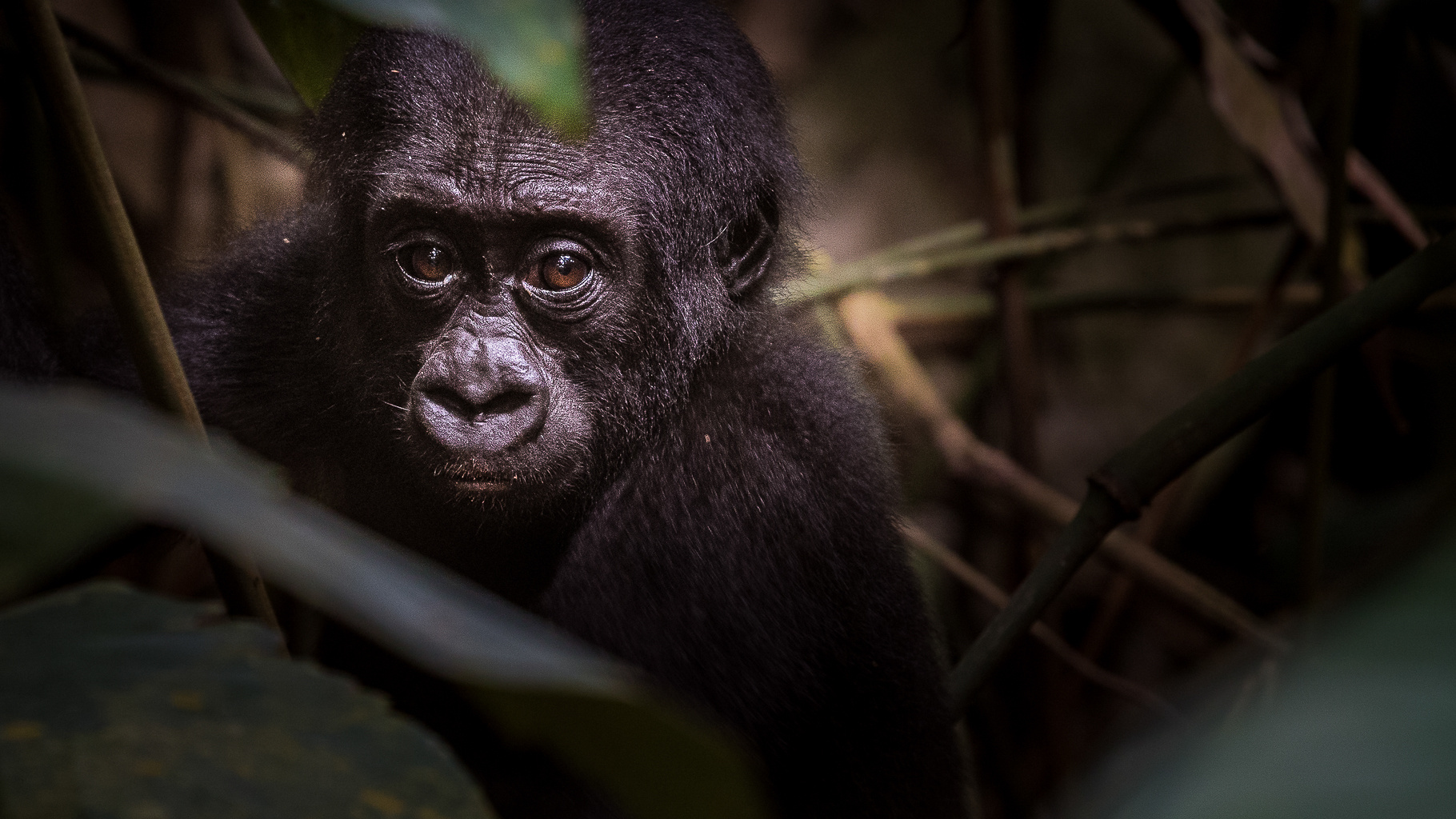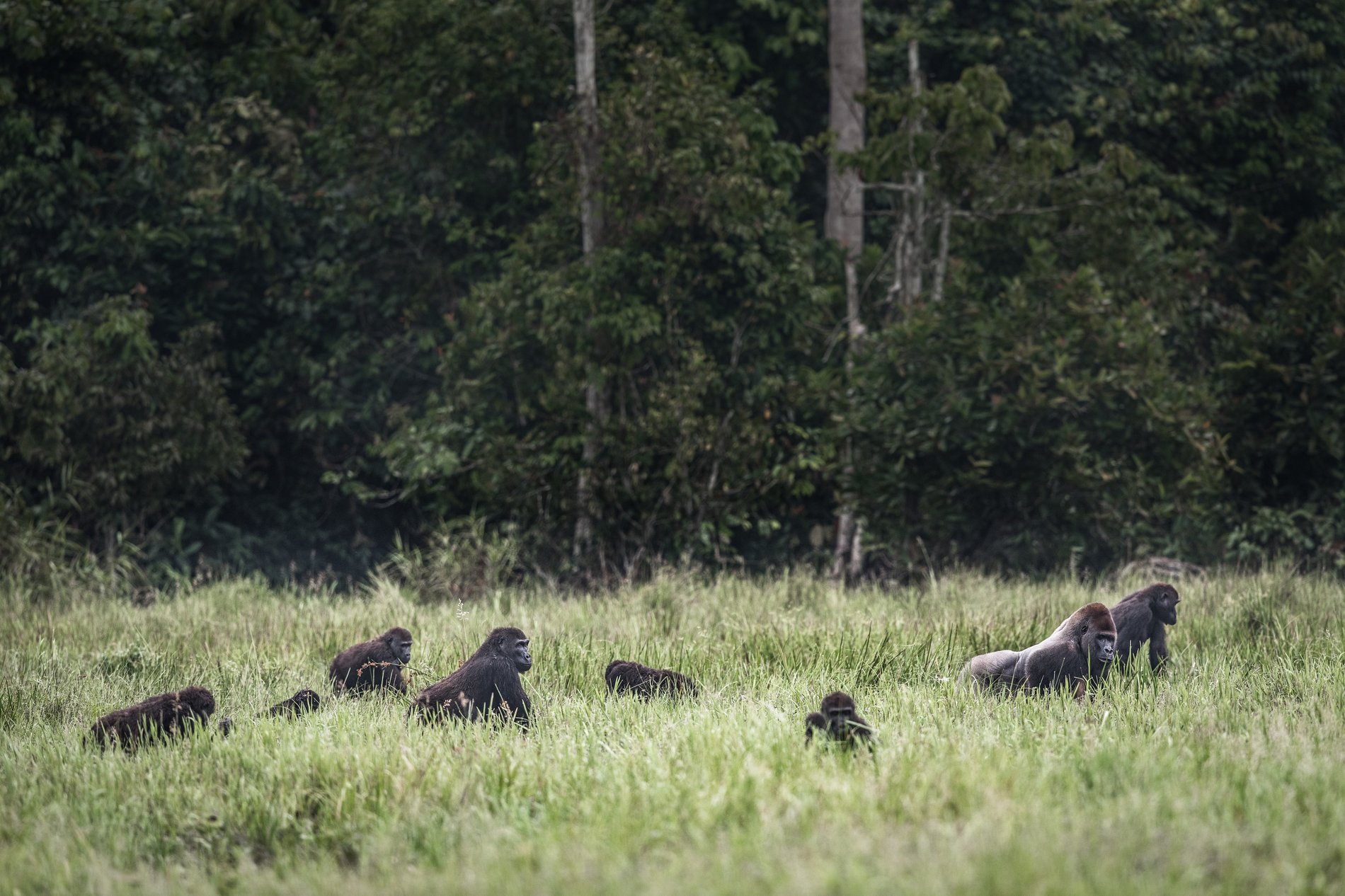
Experience a profound connection with nature as you observe the impressive power and gentle grace of these magnificent primates, tenderly interacting with their families in an untouched habitat. A visit to the park offers a rare and unforgettable experience, bringing you face-to-face with these extraordinary animals and creating memories that will stay with you forever.
Western Lowland Gorilla (Gorilla gorilla gorilla)
Veiled in the lush, humid tropical forests of western Africa, the western lowland gorilla weaves a tale of profound intelligence and deep bonds. Sharing over 98.5% of their DNA with us, these highly social animals exemplify nature's harmony and complexity.Their social structures are a dance of cooperation. Silverbacks lead with wisdom, females nurture with care, and every member has a role. The Marantaceae forests provide vital food, shelter, and safe roost sites, where each night the gorillas nest in trees or on the ground, creating comfortable resting places.
Each morning, as the first light filters through the dense foliage, silverbacks and feeding mothers dwell on the ground, while younger gorillas nimbly ascend the trees, plucking fruits as if reaching for hidden treasures. This synchronized activity underscores their intricate social bonds. Throughout the day, gorillas follow a structured routine. They forage, interact, rest, and nest together at twilight, maintaining unity from dusk to dawn.
Gorillas communicate through a rich tapestry of vocalizations and gestures that display a spectrum of emotions including fear, love, curiosity, and grief. They remember paths and food sources, passing knowledge down through generations. Their use of tools, from sticks to measure water depth to branches for food, shows foresight and innovation.
Watching the gorillas, especially the attentive mothers with their playful young, reveals a social structure that touches the heart. Under the silent watch of the silverback, this dynamic family unit is a poignant reminder of the family bonds and communal care. Protecting these magnificent animals is an act of altruism, ensuring that they can continue to thrive in their forest home.
Habitat and Distribution:
Western Lowland Gorillas inhabit the equatorial humid tropical forests of western Central Africa, including the Republic of Congo, Gabon, Cameroon, the Central African Republic, and Equatorial Guinea. Their daily lives unfold in the rich, lush undergrowth along rivers and swamps within regenerating secondary forests and the Marantaceae forests that provide essential food, shelter, and nesting sites. These environments support the complex social structures and behaviors that define these intelligent and social primates (Center for International Forestry Research: Secondary forest: a working definition and typology).

Appearance:
They are the second largest primates on earth, after the mountain gorillas. Their robust build, long arms, and expressive eyes reflect both strength and intelligence.
- Males: Weighing 160-210 kg and standing 1.4-1.8 meters tall, they command a presence that is both awe-inspiring and majestic.
- Females: Weighing 68-114 kg and up to 1.5 meters tall, they display a grace and nurturing demeanor.
- Distinctive Features: The massive head and unique nose prints make each gorilla a distinctive individual, while the sharp canines of adult males add to their formidable appearance.
- Coat: From blue-black to brownish, with mature males developing a distinguished silver saddle, these gorillas are a sight to behold. Newborns have a tender brownish-grey coat, and their bare skin, black on the nose, lips, ears, chest, palms, and soles, adds to their distinctive charm.
Diet:
Primarily herbivorous, Western Lowland Gorillas exhibit a fascinating dietary palette.
- Primary Foods: Leaves, shoots, stems, roots, bark, shrubs, snails, and dung. Each meal is a carefully selected feast of nature’s bounty.
- Feeding Habits: With skill and precision, they choose the most palatable parts of plants, relying heavily on marantaceae plants to meet their nutritional needs.
Social Behavior:
Living in non-territorial harems led by a dominant silverback, these social structures are a testament to their complex social lives.Western Lowland Gorillas spend their 24-hour day in a harmonious blend of activities. They devote approximately 30% of the day to feeding, another 30% to traveling, and 40% to resting. This resting period includes both their midday rest and nighttime sleep in nests they build each evening. This balance of feeding, exploring, and resting underscores their complex social structures and natural rhythms within their habitat.
Reproduction:
The life cycle of these gorillas is marked by significant milestones.
- Females: First birth at 9-12 years, with a gestation period of 8.5 months and about 4 years between births, highlighting the investment in each precious offspring.
- Males: Reach fertility and silverback status at 11-13 years, ready to lead and protect.
- Group Dynamics: Females often transfer between groups, seeking the best environment to raise their young, reflecting their strong maternal instincts.
Communication and Behavior:
Gorillas communicate with a rich repertoire of facial expressions and vocalizations.
- Aggressive Behaviors: Chest-beating and open-mouth threats are displays of strength and dominance.
- Social Interactions: Tender nose-to-nose greetings, embracing, and social grooming foster deep bonds and a sense of community.
- Daily Patterns: Their activities are synchronized with the silverback, ensuring group cohesion and harmony.
Conservation Status:
Despite an estimated population of around 340,000, Western Lowland Gorillas face significant threats. Habitat destruction, poaching, and diseases like Ebola pose grave dangers.
- Critical Endangerment: With a decline rate of about 3% per year, translating to over 10,000 gorillas lost annually, the urgency for conservation cannot be overstated.
- Conservation Efforts: Protecting these gentle giants involves creating protected areas, reducing illegal hunting, and managing diseases, ensuring that future generations can marvel at their beauty and grace.
Understanding the behavior, habitat, and threats faced by Western Lowland Gorillas underscores the importance of conservation efforts. Protecting these magnificent primates and their environments is not just a scientific necessity but a moral imperative. Let us cherish and safeguard these wonders of the natural world.
(ArcGIS StoryMaps) (BioMed Central) (African Parks)
Conclusion
Understanding the behavior, habitat, and threats faced by Western Lowland Gorillas underscores the importance of conservation efforts. Protecting these magnificent primates and their environments is not just a scientific necessity but a moral imperative. Let us cherish and safeguard these wonders of the natural world. Join us in preserving these gentle giants for future generations.
